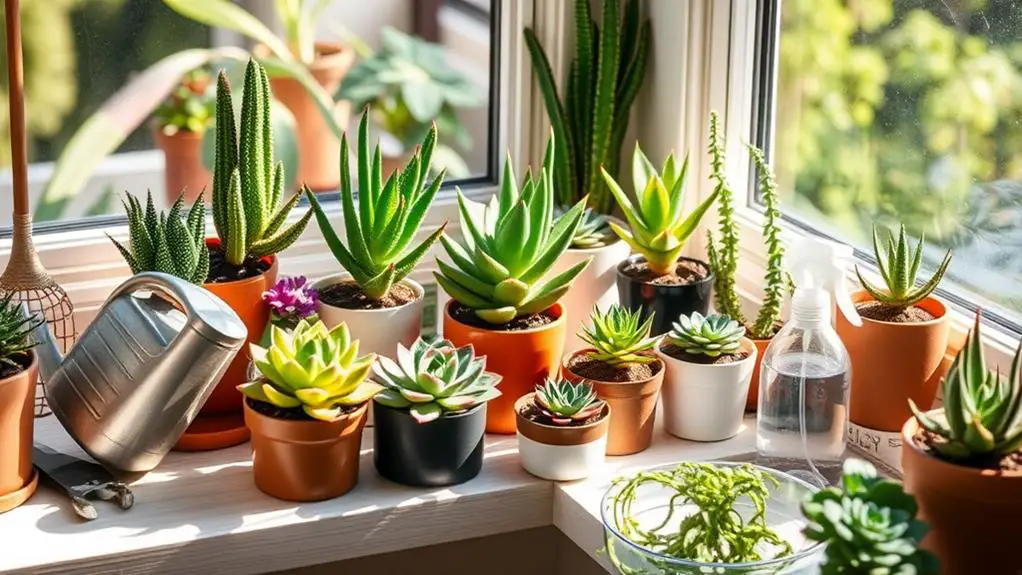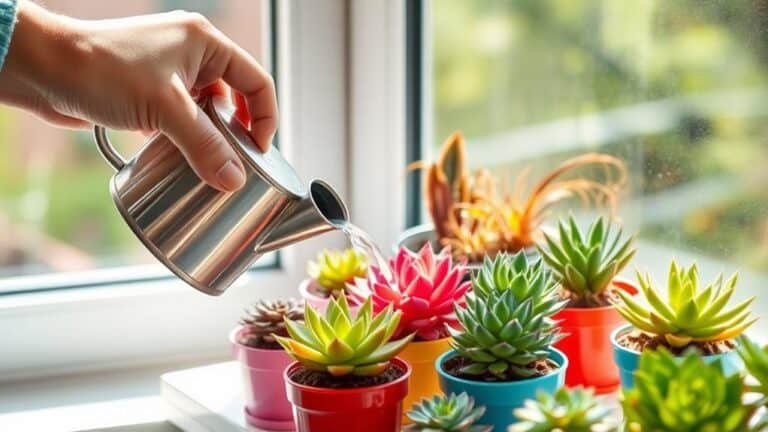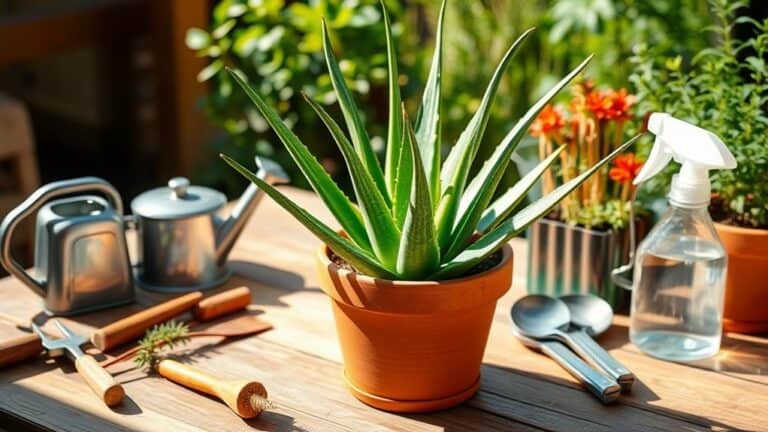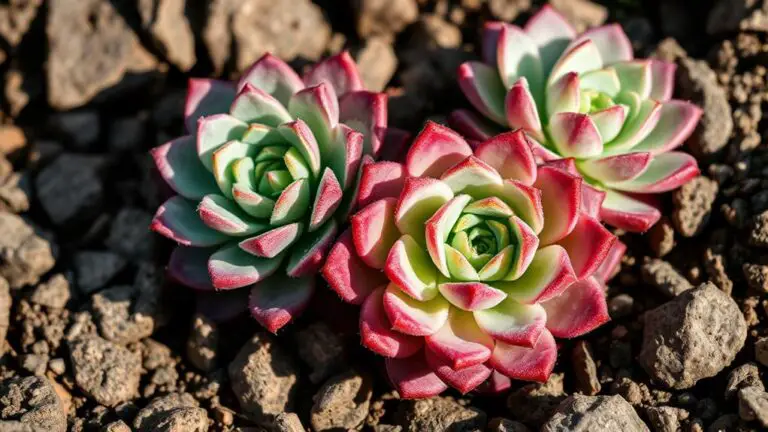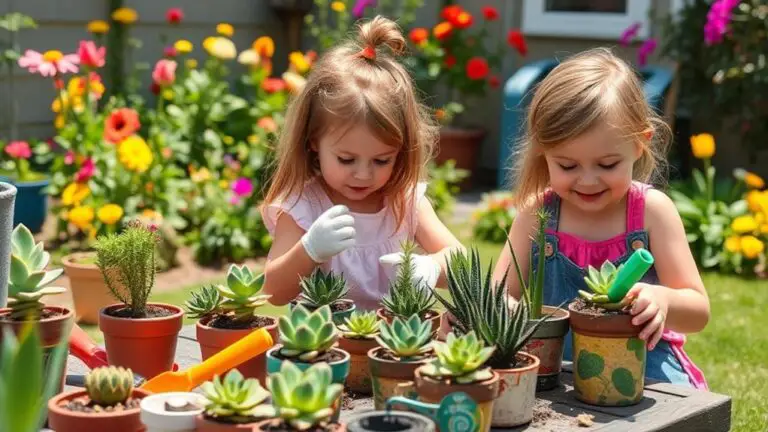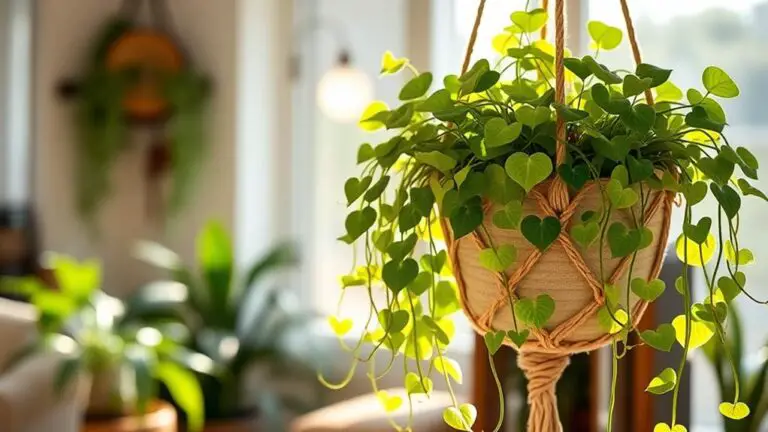7 Easy Steps to Growing Succulents Indoors
If you want to successfully grow succulents indoors, it's vital to follow a few straightforward steps. The journey begins with selecting the right types of succulents that thrive in low-light conditions, such as Haworthia and Gasteria. From there, ensuring they get 6-8 hours of adequate light each day is essential. But light isn't the only factor; proper soil and pot selection also play a significant role in their health. You might think watering is simple, but there's a specific approach needed to avoid common pitfalls. Curious about what comes next? Let's explore the finer details of each step.
Choose the Right Succulents
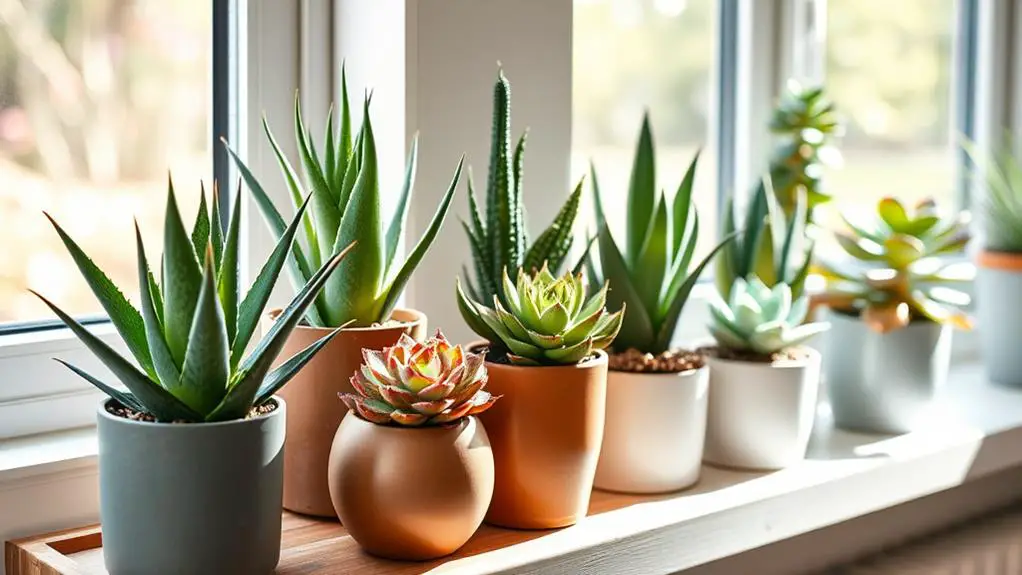
When choosing the right succulents for indoor growth, it's important to select varieties that thrive in low light conditions. Some of the best options for shaded environments include Haworthia and Gasteria. These hardy species are well-suited for the lower light levels found inside your home.
You'll find that their care needs are straightforward, making them perfect for beginners.
Brightly colored succulents like Echeveria and certain types of Aloe might catch your eye, but they usually require more light than what's available indoors. These plants could struggle and show signs of leggy growth if they don't get enough sunlight.
So, it's best to avoid them if your indoor space doesn't offer ample light.
When choosing succulents, consider their growth rates and care requirements. Look for varieties that grow slowly and don't need constant attention.
Hardy species are a great choice because they're low-maintenance and can withstand less-than-ideal growing conditions. This boosts your chances of success and makes the process enjoyable.
Provide Adequate Light
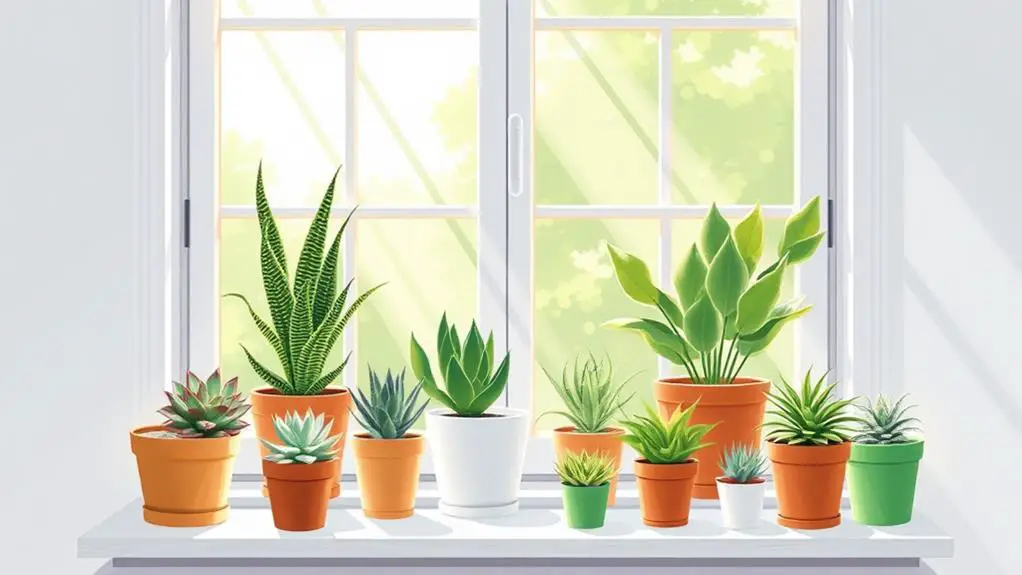
Guaranteeing your succulents get adequate light is essential for their health and growth. Succulents require a minimum of 6 to 8 hours of bright, indirect sunlight daily to thrive. Positioning your plants near south- or east-facing windows can help maximize their exposure to natural light throughout the day.
When natural light is insufficient, especially during the winter, consider using full-spectrum grow lights. These lights mimic natural sunlight and are perfect for giving your succulents the light they need. Insufficient light can lead to weak, leggy plants and poor color, so it's important to monitor the light conditions regularly.
To promote balanced growth, rotate your succulent pots periodically. This guarantees that all sides of the plant receive even light exposure.
Here are some tips to help you provide adequate light for your succulents:
- Place near south-facing windows: These windows provide the most consistent light.
- Use full-spectrum grow lights: Ideal for supplementing natural light, especially in low-light conditions.
- Rotate pots regularly: Helps prevent uneven growth and guarantees all sides receive light.
Use Proper Soil and Pots
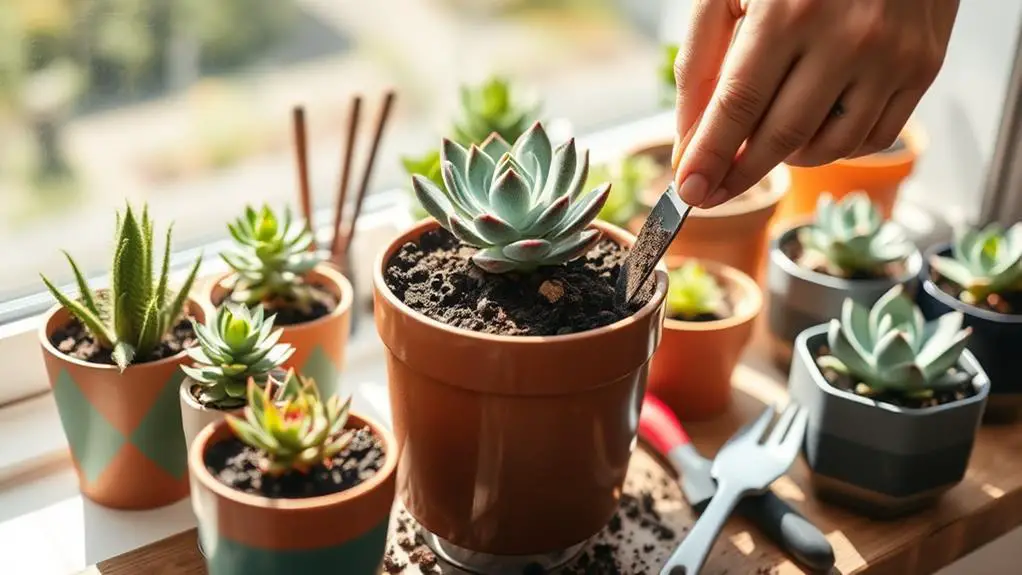
Using proper soil and pots is essential for the health and longevity of your indoor succulents. To start, you need a well-draining soil mix. Combine one-third organic material, like potting soil or compost, with two-thirds mineral material, such as perlite or coarse sand. This mixture guarantees healthy roots by providing the right balance of nutrients and drainage.
Next, choose pots with drainage holes. These holes prevent water from accumulating at the bottom, which can cause root rot. Terracotta pots are a great choice because they breathe well and help with moisture control. They allow air to circulate around the roots, keeping them dry and healthy.
Pick shallow containers that match the size of your succulent. When repotting, increase the pot size by only 1-2 inches. This prevents excess moisture from lingering in the soil.
Also, don't forget to refresh or replace the soil regularly. This keeps it well-drained and full of nutrients, avoiding any root issues from soil degradation over time.
Follow Watering Guidelines
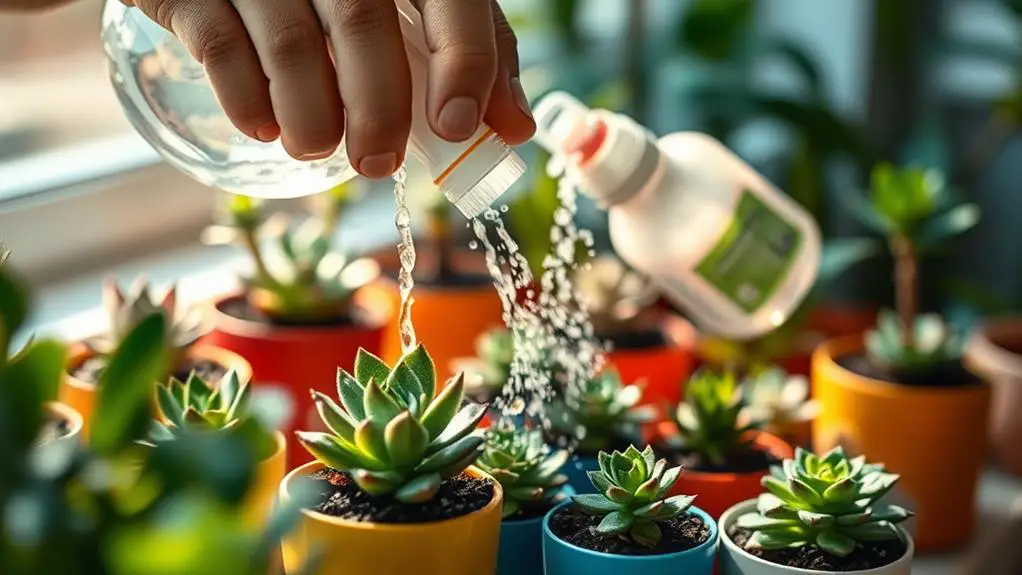
Watering succulents properly is key to keeping them healthy and happy.
Make sure to water thoroughly until it drains from the pot, then let the soil dry out completely before watering again, usually every 2-3 weeks.
Check the soil moisture by sticking your finger in; if it feels dry, it's time to water, but if it's still moist, hold off.
Avoid Overwatering Issues
Preventing overwatering is vital for keeping your indoor succulents healthy. These plants need a balance of water and dry periods to thrive. The biggest mistake people make is watering too often. Here's how to care for your indoor succulents and avoid overwatering.
First, always water your plants only when the soil is completely dry. This usually means every 2-3 weeks. Use your finger to check the soil; if it's dry two knuckles deep, it's time to water. When you do water, make sure to soak the soil until water drains from the bottom of the pot.
- Use pots with drainage holes to prevent excess moisture buildup.
- Reduce watering during cooler months since succulents enter a dormant phase.
- Check the leaves: shriveled or dull leaves mean it's time to water, while floppy leaves indicate overwatering.
Keeping an eye on your indoor succulents' leaves is important. They'll tell you what they need. By following these guidelines, you'll make certain your plants stay healthy and vibrant. Remember, less water is often more when it comes to succulents!
Check Soil Moisture
To guarantee your succulents stay healthy, checking soil moisture is vital. Stick your finger two knuckles deep into the soil; if it feels dry, it's time to water your succulent. When you water, make sure to do it thoroughly until water drains from the bottom. Always allow excess water to escape and empty the drainage saucer to prevent root rot.
Overwatering is the main cause of succulent death. It's essential to let the soil dry out almost completely between watering sessions. A reliable watering schedule typically involves watering every 2-3 weeks, but you might need to adjust based on your home's humidity and temperature.
Watching for signs that your succulent may need water is helpful. Look for shriveling or dull leaves, especially on the lower parts of the plant. Too much moisture, on the other hand, can lead to root problems.
Here's a quick guide to keep in mind:
| Check Soil Moisture | Watering Your Succulent | Signs to Watch For |
|---|---|---|
| Use your finger | Water thoroughly until it drains | Shriveling or dull lower leaves |
| Two knuckles deep | Allow excess water to escape | Soil should be nearly dry |
| Dry soil = time to water | Empty drainage saucer to prevent rot | Avoid overly moist soil |
Stay consistent and attentive, and your succulents will thrive!
Adjust Seasonal Watering
As you keep an eye on soil moisture, it's important to adjust your watering routine according to the seasons. During the warmer months, your indoor succulent will need watering every 2-3 weeks. Make sure the soil dries out completely between waterings. You don't want to give your succulent too much water, as this can lead to root rot.
When the weather cools down, reduce the watering frequency since succulents enter a dormant phase and require even less moisture. To check if it's time to water, insert your finger two knuckles deep into the soil. If it feels dry, then it's time to water. Be especially cautious during the cooler months, as moist soil can be harmful.
Here are a few tips to help you adjust seasonal watering:
- Check for signs of water needs: Wilting lower leaves often mean your succulent is thirsty.
- Empty drainage saucers: Remove excess water to prevent root rot, especially in winter.
- Monitor soil moisture: Regularly check soil moisture to avoid overwatering.
Fertilize Sparingly
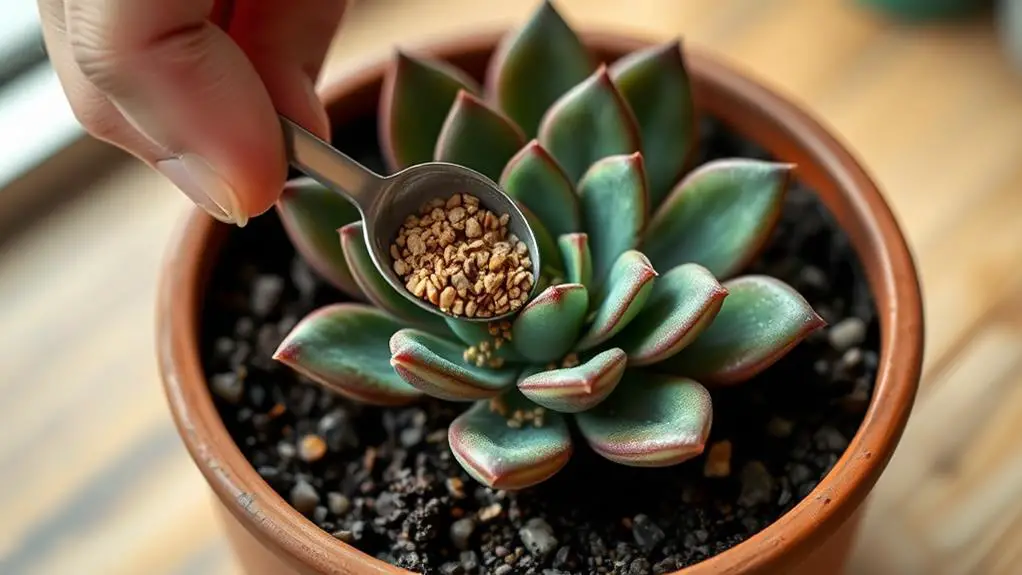
Your succulents' health hinges on your careful approach to fertilization. It's essential to fertilize sparingly to avoid over-fertilization, which can harm these plants.
During the growing season, usually spring and summer, use a balanced fertilizer that's diluted to half or even a quarter strength. This gentle approach guarantees your succulents get the nutrients they need without overwhelming them.
A good rule of thumb is to fertilize after every 3-4 waterings. Remember, the soil should dry out between waterings to prevent root rot. By following this schedule, your succulents can thrive without the risk of nutrient burn.
During the winter months, when succulents enter dormancy, you don't need to fertilize at all. Their growth noticeably slows, and they don't require extra nutrients.
Refreshing the soil with well-draining cactus mixes can also help maintain nutrient levels. This practice reduces the need for frequent fertilization and provides a healthy growing environment.
Manage Pests and Problems
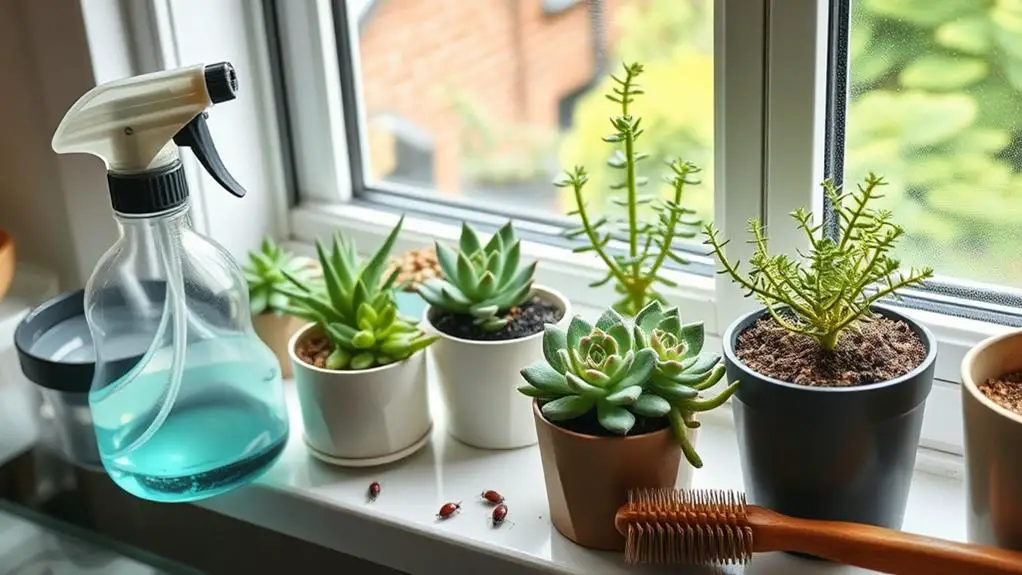
Nobody wants to find pests on their beloved succulents, but regular inspection is vital for keeping these resilient plants healthy. Start by checking your succulents often for pests like mealybugs and gnats. Early detection can save your plants from serious damage. If you spot mealybugs, a cotton swab dipped in rubbing alcohol will kill them on contact.
Make certain your succulents are planted in well-draining soil. This prevents overly moist conditions that attract gnats and cause root rot. Proper soil is key to a healthy plant.
Also, guarantee good airflow around your succulents. Stagnant air can lead to fungal issues and make pest problems worse. Space your plants appropriately to keep the air moving.
Watch for signs of stress like leggy growth or yellowing leaves. These can be clues that something isn't right, like insufficient light or overwatering. Adjust their care to fix these issues before they become bigger problems.
Here are a few tips to keep your succulents healthy:
- Regularly inspect for pests and treat early.
- Use well-draining soil to avoid moisture-related problems.
- Ensure good airflow to prevent fungal issues.
With these steps, you'll keep your succulents thriving indoors.
Repot When Necessary
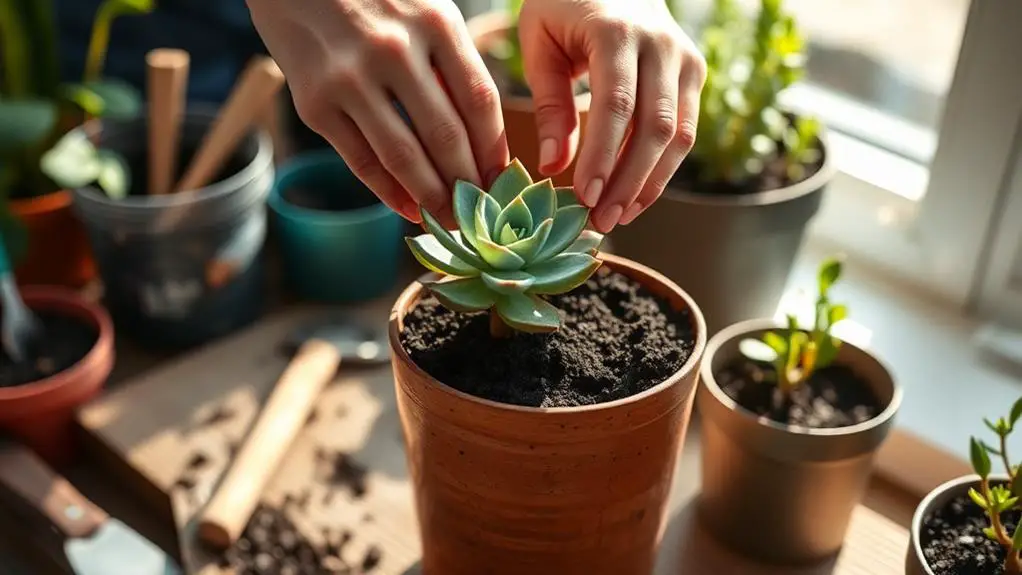
Repotting your succulents every couple of years is essential to keep them healthy and growing strong.
Make sure to choose a pot that's only 1-2 inches larger than the current one, and always use well-draining cactus soil for the best results.
Handle the roots carefully during the process, and check that the new pot has drainage holes to prevent root rot.
Choose Appropriate Pot Size
Choosing the right pot size is vital for the health and growth of your succulents. When repotting succulents, select a pot that's 1-2 inches larger in diameter than the current container. This extra space allows for adequate root growth without overwhelming the plant.
Make certain the pot you choose has drainage holes. These holes are essential as they prevent excess moisture from causing root rot, a common problem for succulents. Shallow containers work well since succulents typically have shallow root systems that don't require deep pots.
Here are some key points to keep in mind:
- Well-draining cactus mix: Use a mix or a blend of potting soil and sand to guarantee proper drainage.
- Regular repotting: Repot your succulents every couple of years or when you see roots growing out of the drainage holes.
- Nutrient levels: Fresh soil during repotting helps maintain nutrient levels and supports healthy growth.
Refresh Soil Regularly
Maintaining healthy succulents indoors requires you to refresh their soil regularly, ideally every 1-2 years. This practice keeps the soil nutrient-rich and guarantees proper drainage, critical for your succulents' thriving. When it's time for repotting, use a well-draining cactus soil mix. This mix should be one-third organic material and two-thirds mineral material. It helps prevent excess moisture retention, which can lead to root rot.
Choosing the right pot is crucial. Select a pot just 1-2 inches larger than the current one to avoid holding too much water. During repotting, inspect the root system. Remove any dead or rotting roots to promote healthy root growth. This is also a great time to propagate new plants. You can use offsets or cuttings to expand your indoor succulent collection.
Here's a quick overview:
| Step | Key Points | Tips |
|---|---|---|
| Refresh soil | Every 1-2 years | Maintain nutrient levels and drainage |
| Use proper soil | Well-draining cactus soil mix | One-third organic, two-thirds mineral |
| Choose right pot | Slightly larger (1-2 inches) than current | Prevent excess moisture retention |
| Inspect roots | Remove dead/rotting roots | Encourage healthy root growth |
| Propagate plants | Use offsets or cuttings | Expand your collection |
Handle Roots Carefully
Handling the roots of your succulents with care is essential to their health and growth. When repotting succulents, it's important to handle roots gently to avoid damage. Their roots are sensitive and can break easily.
Repot your succulents every couple of years or when they outgrow their container, ensuring they've fresh, well-draining soil. This helps prevent excess moisture retention and promotes healthy growth.
When choosing a new pot, opt for one that's only 1-2 inches larger than the previous container. This size helps maintain proper soil moisture levels. Always check for signs of rot or disease during repotting. Trim away any unhealthy roots with sterilized scissors to keep your plant thriving.
Make sure the new pot has adequate drainage holes. Good drainage is essential for preventing root rot and ensuring your succulent's roots stay healthy.
Here's a quick checklist to keep in mind:
- Handle roots gently to avoid breakage.
- Use fresh, well-draining soil when repotting.
- Choose pots with proper drainage holes.
Frequently Asked Questions
How Do You Plant Succulents for Beginners Indoors?
Start by choosing a shallow pot with drainage holes. Use a well-draining soil mix, place your succulent in bright, indirect sunlight, and water thoroughly, allowing soil to dry completely between watering. Adjust care as needed.
How Do You Keep Succulents Alive Indoors?
Keep succulents alive indoors by giving them at least 6 hours of bright, indirect sunlight daily. Water them thoroughly but let the soil dry out completely between waterings. Use well-draining soil and pots with drainage holes.
How Do You Arrange Succulents Indoors?
Arrange succulents by light needs, placing sun-lovers near windows. Use varying heights for visual appeal and decorative pots with drainage. Group plants with similar growth rates and use trays for smaller succulents to simplify watering.
How Do You Prepare Succulents for Indoors?
Choose indoor-friendly succulents like Haworthia or Aloe. Pick well-draining pots with drainage holes and breathable materials. Use sandy, well-drained soil. Place them in bright spots with indirect sunlight, and water infrequently, letting soil dry completely.
Conclusion
By following these seven simple steps, you'll find that growing succulents indoors is both fun and rewarding. Choose the right plants, give them enough light, and use the proper soil and pots. Stick to the watering guidelines, fertilize sparingly, and keep an eye out for pests. Don't forget to repot every once in a while. With a bit of care, your succulents will thrive, bringing a touch of green to your home. You've got this!

